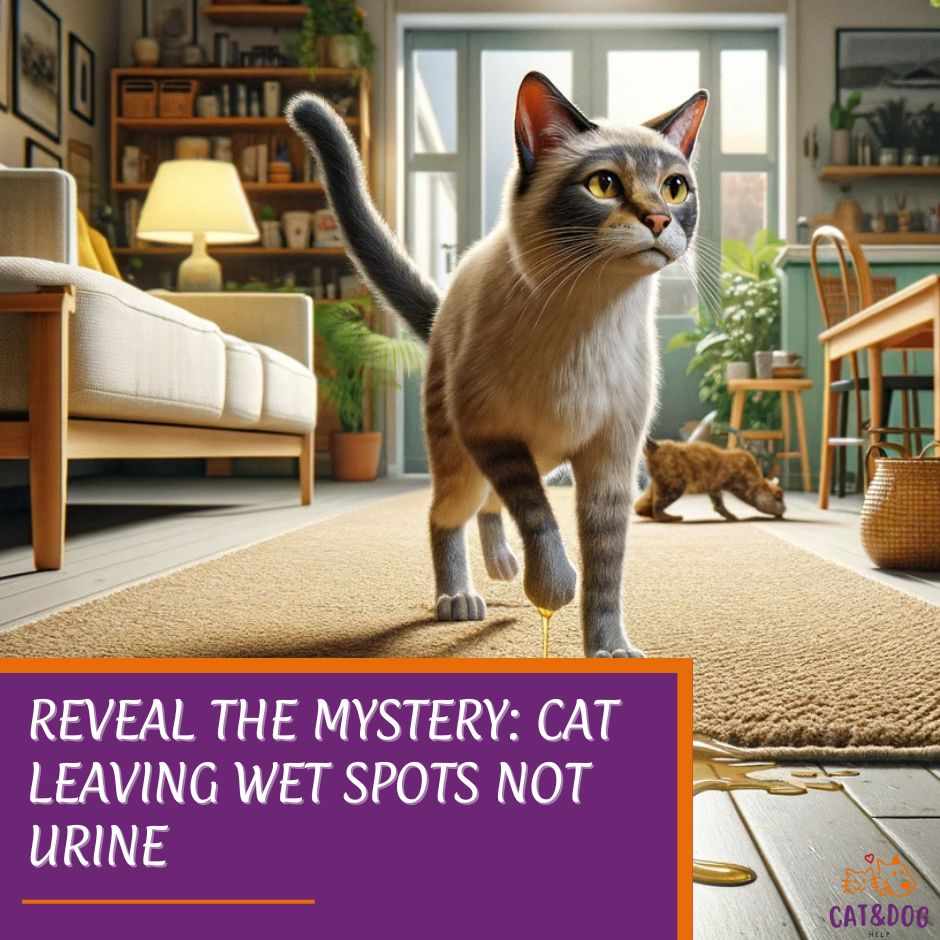Have you ever noticed your cat leaving wet spots not urine around your home?
It’s a situation that can be puzzling and concerning for any cat owner, especially if you have a male cat.
As we unwrap this mystery, it’s important to understand that your kitty isn’t doing this out of spite or behavioral issues.
In this case, it could be a sign of a medical issue, such as a urinary tract infection, bladder stones, or urinary incontinence related to kidney disease. (1)
It’s important to take your male cat to a veterinarian for a thorough examination and diagnosis, including checking their anal glands.
In this article, we delve into the nitty-gritty of why your male cat might be leaving these wet spots, highlighting both the medical and behavioral sides to give you a comprehensive insight into the issue of small amounts of urine and potential gland issues.
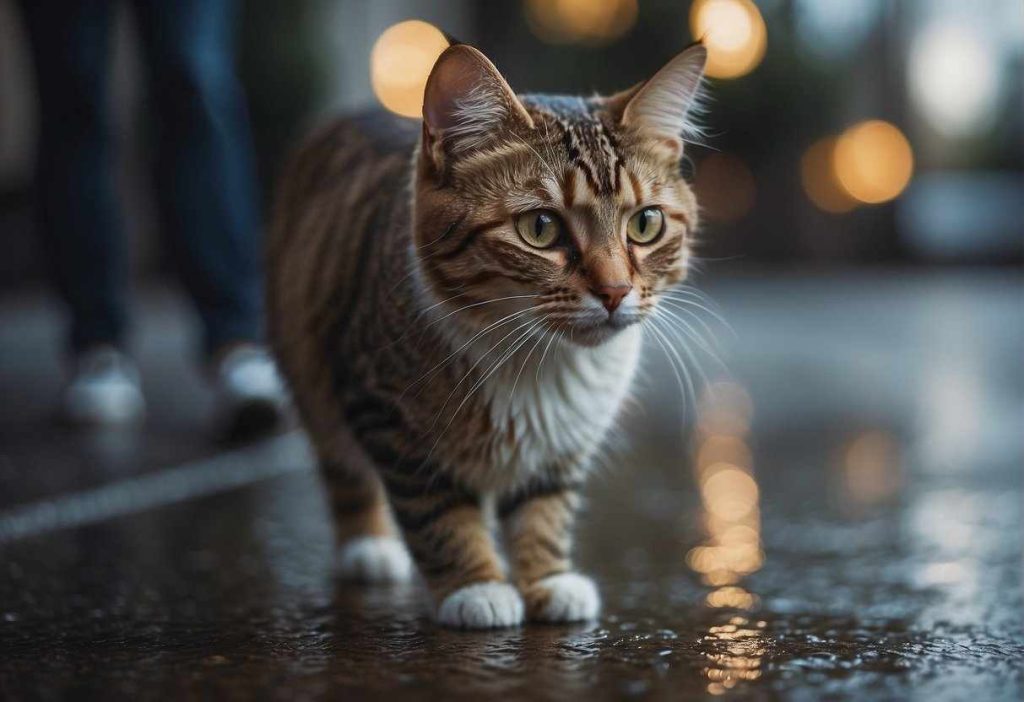
From hidden health issues to quirky habits, there are a number of reasons why your cat might be creating these damp patches.
It could be a silent signal that your cat is experiencing dental issues like gum disease, or something more hidden like incontinence or a urinary tract problem. (2)
Don’t worry; you’re not alone in your quest for answers, and yes, we’ll help you sort the facts from feline fiction with the help of experts on JustAnswer.
Alongside practical advice, you’ll be equipped with strategies for home care and insights into your cat’s peculiar behaviors.
So, let’s get to the bottom of this (pun intended) and make sure you and your kitty stay happy and healthy, with dry carpets to boot.
Key Takeaways
- Non-urine wet spots in cats can indicate dental or urinary health issues.
- Understanding your cat’s behavior and health can lead to proper home care.
- Regular vet check-ups and preventive measures ensure long-term well-being.
Common Causes of a Cat Leaving Wet Spots Not Urine
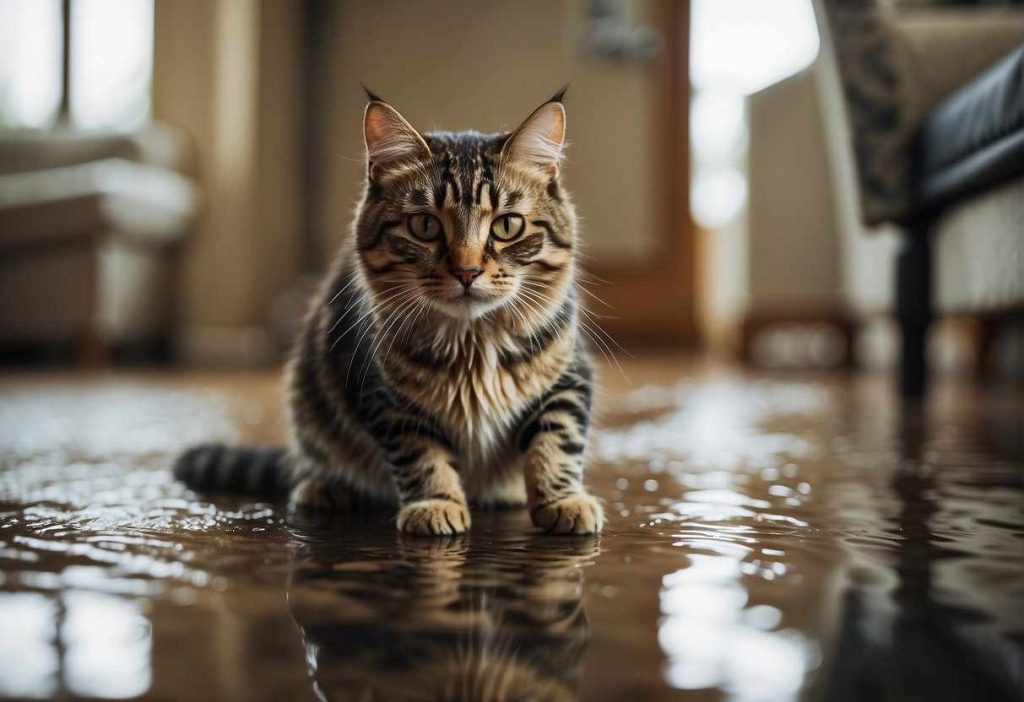
Ever found a mysterious wet spot and wondered why your feline friend is leaving it around, especially when it’s not urine?
It’s not just puzzling, it’s also a concern for many cat parents like you. Here’s what might be happening:
Medical Conditions:
- Urinary Tract Infections (UTIs): If your cat is frequently attempting to urinate with little success, there might be an infection causing inflammation of the bladder. (3)
- Bladder Issues: Bladder stones could irritate your cat’s bladder, leading to distress and leakage. (4)
- Incontinence: Just like humans, cats can experience involuntary leaks, often seen in senior felines or those with certain health concerns.
Behavioral Reasons:
- Stress and Anxiety: Is your kitty stressed out? Changes in the environment or routine can lead to anxiety, which may result in abnormal urination behaviors. (5)
- Territorial Instincts: Your cat might feel the need to mark territory, but when it’s not urine, it could be a sign of a deeper issue. (6)
Symptoms to Watch For:
- Vaginal discharge in female cats, possibly indicating infection or other health issues.
- Peeing outside the litter box, despite being well-trained.
- Showing signs of distress while trying to urinate.
These conditions differ from normal behavior because they typically involve discomfort, pain, or changes in routine urination patterns.
If you’re noticing any of these symptoms, such as inappropriate urination, it might be a good idea to chat with your vet.
They can provide an accurate diagnosis through a complete medical history and physical examination, and recommend additional diagnostic tests to exclude or diagnose other conditions if preliminary tests do not yield a diagnosis, or to understand the impact of urinary incontinence on your pet.
These tests are selected on a case-by-case basis. Examples include behavioral reasons, bladder stones, overflow incontinence, and urinary tract infections.
This will help keep your kitty comfortable — and your home dry from this potential behavioral problem!
Practical Advice and Home Care Strategies
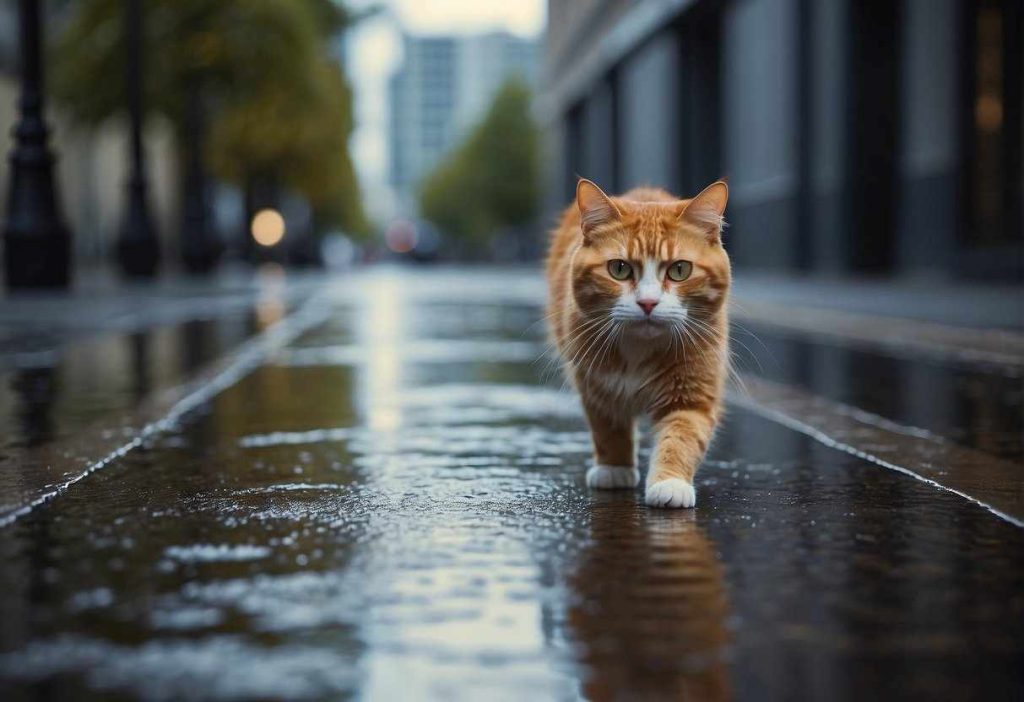
Caught a mysterious wet patch on the couch again? Hmm, let’s tackle this together!
Spot Cleanup Don’t worry, you’ve got this.
- Fresh Mess? Blot, don’t rub, with a towel.
- Odor Lingers? Mix one part water with one part vinegar, spray, and let it sit, then blot away.
- Old Stains? Baking soda is your pal. Sprinkle, let sit, then vacuum.
Observation is Key
Keep an eye on your furry friend. Do they seem comfortable and happy or is there a grimace on their whiskered face when they settle down?
- Behavior Changes: Note any unusual behaviors.
- Health Signs: Any changes in appetite? That’s worth jotting down. (7)
🐾 Pro Tip: Keep a “Cat Diary” for a week. It’ll come in handy…
Vet Time?
Is the wet spot issue recurring? It’s better to be safe and give your vet a ring. Don’t forget to:
- Describe the Symptoms: When did you first notice this?
- Share Your Cat Diary: It’s full of clues!
- Ask Questions: Worried about bladder stones or UTIs? Your vet’s there to help.
Creating a Support System
Your vet isn’t just someone you see for shots; they’re your partner in pet parenting. Ensure they’re comfortable with incontinent issues, should that be the diagnosis – not all are, but most are open to learning.
Remember:
| In Your Corner | How They Help You |
| Your Vet | Health assessment & plans. |
| Online Forums | Shared experiences and tips from other cat owners. |
| Specialist Products | Waterproof pet blankets save the day, and your sofa! |
Friendly reminder, fellow cat enthusiast: you’re not alone on this, and you know your furball the best. Lean on that instinct – it’s purr-etty accurate. Now, let’s keep those mysterious wet spots in check, okay? 🐾
In-Depth Analysis of Feline Behavior
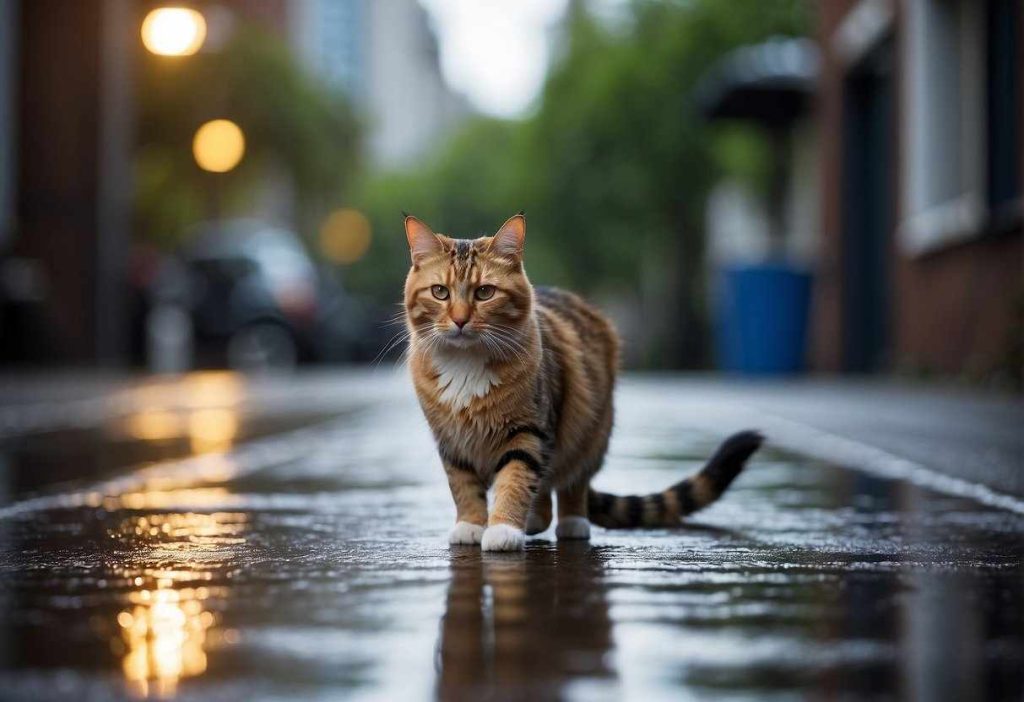
Cats are mysterious creatures, but let’s understand why they might be leaving these marks—it’s not always what you think!
What’s Going On?
- Drooling: Sometimes, a relaxed kitty might drool. That’s right! Drooling cats may leave damp spots that resemble other, less welcome signs.
- Stress: Stress in cats can manifest in unusual ways, including drooling. A change in environment or routine can unsettle them.
- Health Issues: Excessive drooling can also indicate a health issue—always worth a vet check!
- Incontinence or Bladder Problems: Accidents happen, and they are not always due to urine. Cats with bladder issues might leak small amounts of fluid.
- Infections: UTIs can cause discomfort and unexpected leakage.
- Bladder Stones: These can irritate a cat’s system, leading to incontinence.
Creating Comfort
Your cat’s environment plays a massive part in their behavior. So how do you make sure it’s as stress-free as possible?
- Routine: Cats love predictability. Try to feed, play, and clean the litter box at similar times daily.
- Safe Spaces: Offer various cozy hideouts where they can watch the world securely.
- Cleanliness: A pristine litter box invites use, while a dirty one could cause avoidance.
Remember, changes in your feline’s habits are often the first clue that something’s amiss. Keep an eye out, and always consult your vet if you’re unsure.
Cats are part of your family, and understanding them ensures they stay happy and healthy in your shared home.
Enhancing Understanding Through Real-Life Examples
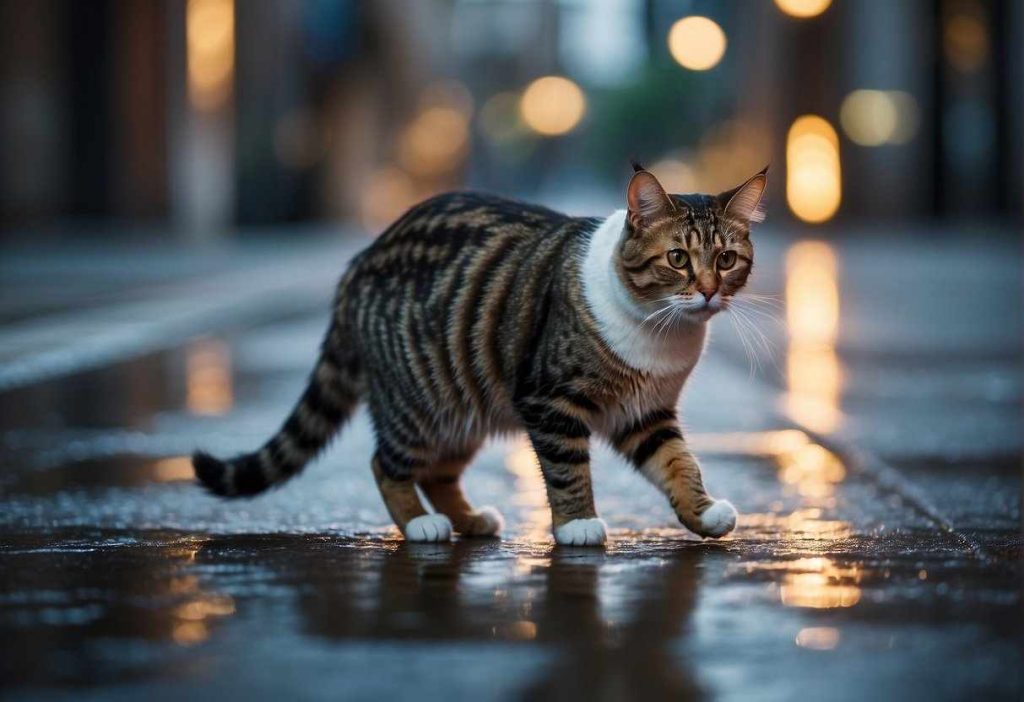
Case #1: Mr. Whiskers’ Drool Mystery
Imagine finding wet spots on your couch and immediately thinking, “Not again, Mr. Whiskers!”. Turns out, it wasn’t what you thought.
After a vet visit, you find that poor Mr. Whiskers has dental issues causing excessive drooling. Who would’ve guessed? Treatment included dental care, and just like that, no more unexpected couch showers.
Solutions:
- Vet consultation
- Dental treatment
Outcomes:
- Happy cat, dry couch!
Case #2: Bella’s Secret Stress
Then there’s Bella, who started leaving spots during a move. Stress can do funky things to a cat, including causing them to overgroom or drool.
A quiet space and some soothing pheromones turned Bella’s stress into zest.
Solutions:
- Stress reduction
- Pheromone diffusers
Outcomes:
- Less grooming, more purring!
Remember, each cat is unique, just like you! If you encounter this slippery situation:
- Check for drooling due to dental or stress-related issues.
- Rule out other health concerns with a vet.
- Implement solutions tailored to your furry pal’s needs.
Remember, these are just examples. Your cat’s story might be different, and that’s okay! Keep your vet on speed dial, and you’ll have the mystery solved in no time.
Let your cat’s unique quirks guide you to a happy and dry resolution.
Preventive Measures and Long-term Care
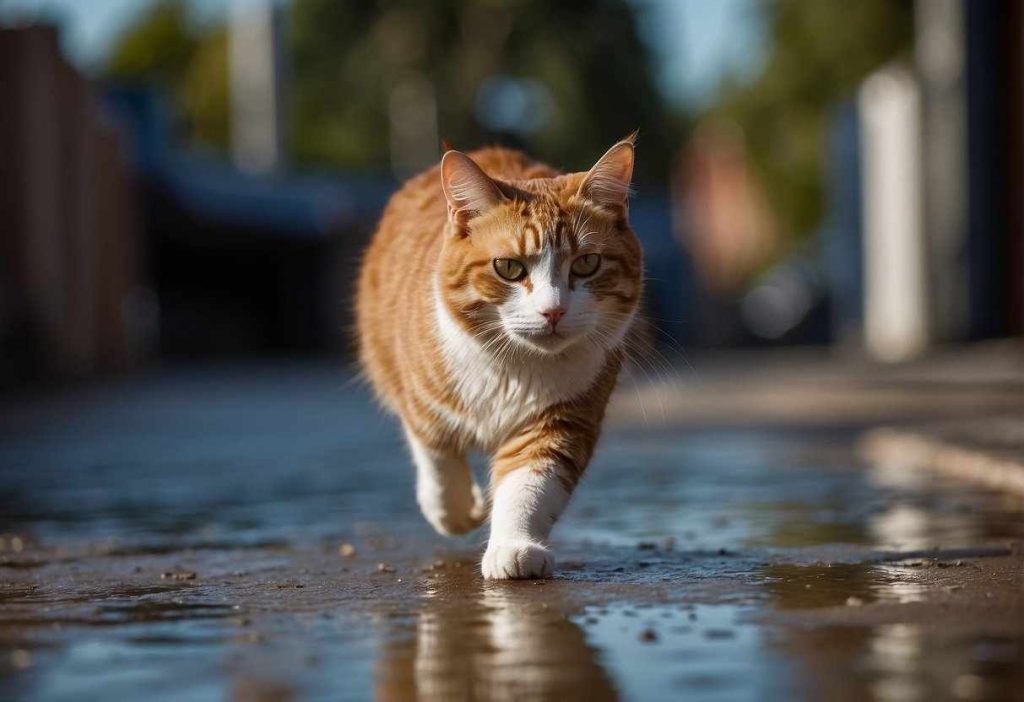
Let’s dive into some simple steps that will keep your feline friend happy, healthy, and dry.
First things first, diet is key! Cats are like us, after all – you wouldn’t want to live on junk food, would you? A balanced diet keeps their urinary system in check. Here are some quick tips:
- Water: Encourage drinking by placing water bowls around your home. Hydration is super-important.
- Wet Food: A splash of it can help maintain adequate water intake.
- Quality Kibble: Opt for high-quality dry food specifically designed for urinary health.
Regular health check-ups are like a secret weapon in preventing mishaps. Think of your vet as your sidekick in the crusade for your cat’s well-being.
- Vet Visits: At least once a year, more if you’ve got a senior kitty.
- Health Records: Keep a log of any changes – it helps the vet spot trends.
Lifestyle tweaks can be a life-changer. Check this out:
- Exercise: Keeping active can prevent obesity, a notorious troublemaker for cats.
- Stress-Free Zone: High-strung environments can lead to anxious bladders. Keep the chill vibes going!
Remember, every cat is unique, so what works for one might not cut it for another. It’s all about the detective work – monitoring behavior, being on the lookout for any odd signs, and taking swift action.
Keep this guide in your back pocket, and you and your furry detective will be on the case for dry, happy days ahead!
Long-Term Management and Follow-Up Care

Got a drooler? Sometimes, it’s just excessive joy, but it could also be a health hiccup.
- Routine Vet Visits: Check in with your vet regularly. They’re like the detectives of the animal world, keeping tabs on your cat’s health.
- Frequency: At least once a year, more if your cat has a chronic condition.
- Dietary Adjustments: You are what you eat, and so is your kitty.
- Hydration: Encourage water drinking; think of it as a spa day for their urinary system.
- Special Diets: Your vet might suggest a special menu to keep their inner workings purring smoothly.
Enrichment and Training:
- Playtime: Believe it or not, your cat does want to have fun. Toys = less stress.
- Scratch that Itch: Scratching posts can save your furniture and your cat’s sanity.
Preventive Care:
- Stress Reduction: Think of your home as a cat’s zen garden. Keep changes minimal; consistency is calming.
- Exercise: Felines need fitness too! Encourage movement to keep that stress meter low.
Remember, you’re the key to your cat’s well-being. Keep things positive, stress-free, and engaging.
Your furry companion is relying on you for a warm and secure environment, so make those follow-up vet visits, tweak their diet as recommended, and keep their mind and body active.
It’s important to continue this long-term management and follow-up care for your kitten to ensure a happy and healthy life.
Quick Recap
Let’s take a quick moment to scratch the surface and unravel this mystery.
- Possible Reasons for Wet Spots: Excessive drooling, which can happen due to various health conditions.
- Bladder leakage, although this is quite a rare scenario.
- Medical issues like urinary tract infections or kidney problems.
- Behavioral issues, such as marking territory or stress.
Identifying the Problem: Identifying the exact cause requires a bit of detective work. Keep an eye out for:
- Any changes in behavior or appetite.
- The color and odor of the wet spots.
- Whether your cat is visiting their litter box more (or less) often.
Remember, cats are masters of hiding discomfort, so it’s up to you to be attentive!
Engaging with Your Cat: Understanding these signs can significantly help in enhancing the bond between you and your cat:
- Spend quality time to notice any subtle changes.
- Provide regular health check-ups to catch issues early.
By staying informed and observant, you’ll not only ensure the well-being of your cat but also fortify that special connection you share. Who knew that detective work could be so rewarding?
Frequently Asked Questions
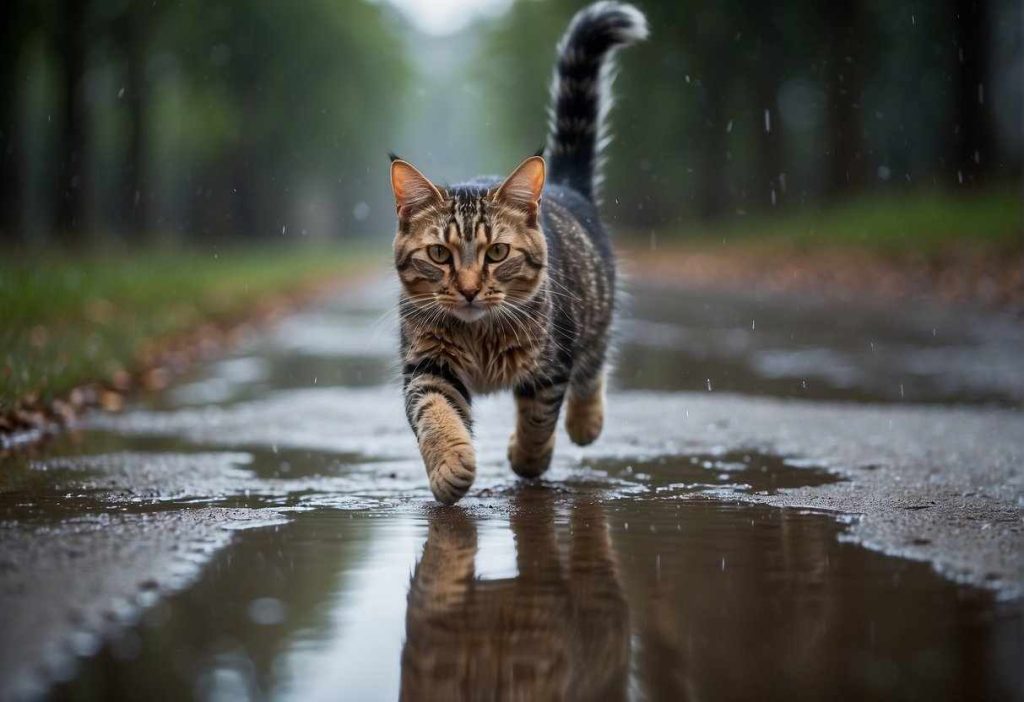
When your fuzzy companion starts leaving wet spots around the house, and it’s not urine, you’re right to be curious. Let’s tackle your burning questions head-on, so you know just what steps to take next.
What are the most common medical reasons for a cat leaving wet spots that are not urine?
Your cat may be dealing with several medical issues, like excessive drooling due to dental problems or stress.
It’s also possible they could have a condition causing bladder leakage, even though this is quite rare for felines.
How can I differentiate between a behavioral and a medical cause for these wet spots?
Medical causes often come with other signs like changes in appetite or litter box behavior, while behavioral causes might be linked to anxiety or environmental changes.
Scrutinize their routine and look for other unusual behaviors.
What immediate steps should I take if I notice non-urine wet spots?
Start by keeping the affected areas clean to prevent skin infections and make an appointment with your vet. They’ll help determine if there’s a medical issue at play.
Can stress or anxiety in cats lead to this kind of behavior?
Yes, stress or anxiety in cats can manifest in various unusual behaviors, including leaving wet spots.
Changes in the home, a new pet, or even a new piece of furniture can unsettle your cat.
What are some effective ways to prevent this behavior in cats?
To ward off this behavior, provide a stable environment, engage in regular playtime, and make sure they have a clean, quiet place for their litter box.
These steps can help your cat feel secure and stress-free.
How can I tell if my cat’s behavior is a sign of a serious health issue?
If your cat is also lethargic, not eating, vomiting, or showing distressed litter box behavior, these could be red flags for serious health issues.
Keep a close eye on their overall demeanor and don’t hesitate to consult your vet if you’re concerned.
How do I approach my vet about this issue, and what information will they need?
Be straightforward with your vet about what you’ve observed, including the frequency, size, and location of the wet spots.
Also, share any changes in your cat’s behavior or routine; this information is key for a proper diagnosis.

